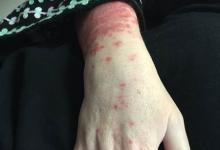Worse Outcomes in HLA-B27+ JIA Save

Key Takeaways
- The HLA-B27 genetic marker is known to be associated with increased risk for various arthropathies, including JIA.
- Whether the genetic marker's presence has prognostic value has been uncertain.
- In this large Scandinavian study, HLA-B27 was associated with worse outcomes in adulthood, especially for males.
Patients with juvenile idiopathic arthritis (JIA) who carried the HLA-B27 genetic marker tended to have worse long-term outcomes, including lower rates of drug-free remission, in a prospective Scandinavian study.
Among 434 patients followed in the cohort, odds of still showing active disease or needing medication 18 years after joining the study were nearly tripled in HLA-B27 carriers (OR 2.6, 95% CI 1.5-4.3), according to Maria Ekelund, MD, PhD, of Uppsala University in Sweden, and colleagues.
Failing to achieve remission was especially common in male HLA-B27 carriers, with an odds ratio of 5.6 (95% CI 2.3-13.7). Risk of no-remission status was numerically elevated in female carriers too, but it fell short of statistical significance (OR 1.7, 95% CI 0.9-3.3).
"The results raise the question of whether screening for HLA-B27 should be considered for all patients with JIA," Ekelund's group concluded in the paper in ACR Open Rheumatology.
HLA (human leukocyte antigen) genes are part of the major histocompatibility complex that allows the immune system to distinguish foreign from self proteins. The B27 type has long been associated with increased risk for arthropathies including reactive arthritis, spondyloarthritis, and psoriatic arthritis, as well as JIA. Testing for HLA-B27 is sometimes performed clinically to aid in differential diagnosis for patients with swollen or painful joints.
Many studies have documented associations between HLA-B27 and certain autoimmune manifestations such as uveitis, sacroiliitis, and enthesitis. Whether it has prognostic value is less clear. An earlier study by many of the same researchers authoring the current work had demonstrated "a more chronic disease course" for HLA-B27 carriers after the cohort had been followed for 8 years.
Now, with 10 years of additional data, that finding is confirmed and extended.
A total of 510 patients were enrolled in the cohort, of whom 434 were still participating at year 18. HLA-B27 tests were completed in 416, and remission status ascertained in 406.
Inactive disease was defined as absence of swollen or painful joints and uveitis, as well as other symptoms such as fever or splenomegaly. It also required normal values for systemic inflammation markers such as erythrocyte sedimentation rate. To be considered in medication-free remission, patients had to maintain inactive disease for at least 12 months while off anti-arthritis and anti-uveitis drugs.
Just under one-third of the cohort were male. Some 22% overall had the HLA-B27 genotype; carrier positivity was greater for males versus females, who accounted for 40 of 93 carriers. Median age at onset was 8.3 years for carriers and 5.3 for noncarriers.
Certain joints seemed preferentially associated with HLA-B27, particularly the sacroiliac, hip, and subtalar joints, and this remained apparent through the full 18 years of follow-up. At the last exam, when all patients were adults, male carriers were more likely than females to show active disease in these joints as well as in the metatarsophalangeal joints.
Additionally, presence of inflammatory back pain, enthesitis, and uveitis at enrollment were each associated with increased risk for missing remission at year 18 among HLA-B27 carriers. Uveitis was a particularly strong predictor for carriers, with an odds ratio of 16.5 (95% CI 2.1-129) for no-remission status at year 18 versus patients without baseline uveitis.
Limitations to the study included small numbers of patients with specific presentations (e.g., only 27 had sacroiliitis confirmed on imaging). Also, the cohort started at the dawn of biologic therapy for JIA, "which might impede comparison with outcome studies performed today," Ekelund and colleagues noted.
Source Reference: Ekelund M, et al "Clinical impact of HLA-B27 on juvenile idiopathic arthritis: Eighteen years of follow-up in the population-based Nordic juvenile idiopathic arthritis cohort" ACR Open Rheumatol 2025; DOI: 10.1002/acr2.70005.









If you are a health practitioner, you may Login/Register to comment.
Due to the nature of these comment forums, only health practitioners are allowed to comment at this time.